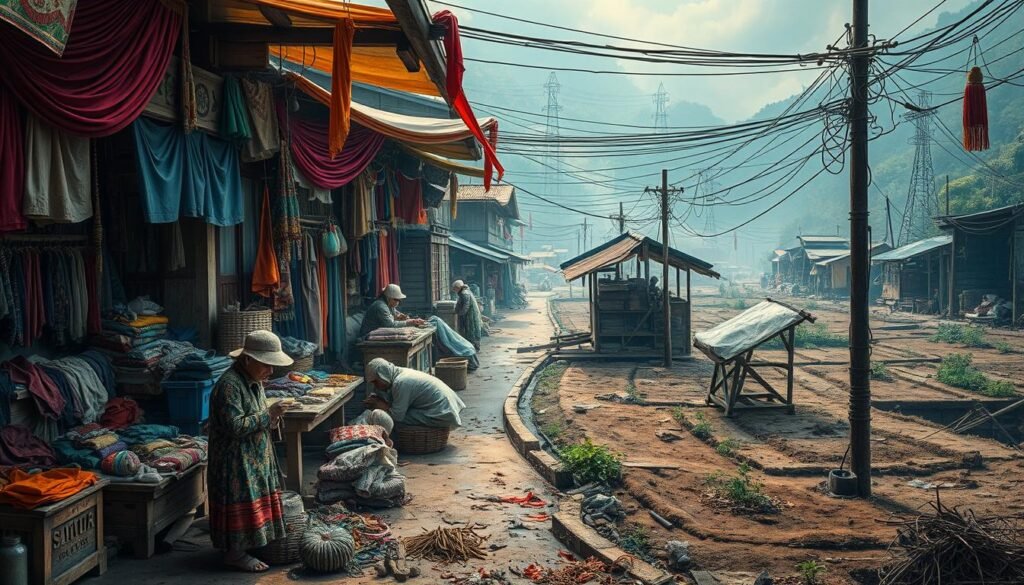“The only way to make sense out of change is to plunge into it, move with it, and join the dance.” – Alan Watts. This quote shows how the silk trade has changed yet stayed important over the years. The history of silk is rich. It goes back thousands of years to when China started making silk in 2,700 BCE. The Silk Roads were important for sharing culture and trade between countries.
Today, silk is still key to the world’s economy. The New Silk Road area makes up over 40% of the world’s money. It includes eight of the top 20 biggest economies. The old trade routes kept the art of making silk alive. They also embraced new ways to meet what people want today. Silk today means luxury, comfort, and being kind to the planet. It especially stands out in custom-made silk items like pajamas, headbands, and pillowcases. Tianruiyi is at the front of custom silk pajamas. Check out what they offer here.
Looking closer at the silk trade shows us how it’s made and its big role in the economy. We see the hurdles and new ideas in the silk industry today. This helps us understand why silk is still so valued in our time.
Key Takeaways
- The global silk trade is a blend of historical traditions and modern logistics.
- Silk production has roots dating back to 2,700 BCE in China, marking its longstanding significance.
- The New Silk Road contributes significantly to the global economy, housing eight of the top 20 economies.
- Silk’s cultural and economic relevance is maintained through contemporary trends, such as customization.
- The broader implications of silk trade highlight both challenges and opportunities in today’s market.
Historical Context of the Silk Trade
The silk trade is a key part of ancient history. It started with the art of raising silkworms in China around 2700 BCE. Only the Chinese imperial court knew how to make silk for many years.
This lovely cloth’s demand grew over time. The silk trade linked many cultures across great distances.
Ancient Origins of Sericulture
Sericulture began in early Chinese society. It greatly changed their social and economic life. By the 1st century CE, everyone wanted Chinese silk.
Places like Rome, Egypt, and Greece loved it. Making silk was a secret. But the danger didn’t stop traders. They crossed hard paths to bring silk to the world.
The silk trade did more than make money. It created a trade network called the Silk Road. This network linked different cultures. They shared ideas, religions, and tech.
The Role of the Silk Roads in Cultural Exchange
The Silk Roads were very important for a long time. They started in the 2nd century BCE and lasted until the 15th century. These roads were very long, stretching over 6,400 kilometers.
Merchants traded many goods along these roads. Not just silk, but also tea, dyes, and more. They connected China to Europe. This helped different cultures mix.
Learning about the Silk Road helps us understand old trade. As seen in historical analyses, it influenced many societies. It helped make the world connected like it is today.
Silk Production Techniques and Innovations
Silk production is both an art and a science with deep historical roots. It involves raising silkworms and using precise methods to make the finest silk. The focus on eco-friendly practices helps the industry grow and reduce its impact on nature.
Sericulture: The Art of Silk Cultivation
Silk making started in China around 2700 BCE. It is based on traditions and expert skills. Sericulture means taking great care of silkworms that eat mulberry leaves. These worms then create silk fibers in their cocoons. Keeping the right conditions for the larvae is key.
The spread of sericulture to Korea and Japan showed the importance of these methods. They matter a lot for both economic and cultural reasons.
Technological Advancements in Silk Production
New silk technology has changed the industry. It makes making silk easier and more efficient. The 19th century’s Jacquard looms made silk weaving faster. They allowed for complex designs.
Recently, companies like Alibaba have spurred growth through online platforms. They link producers with global markets and encourage eco-friendly steps. This is part of the Alibaba Green Alliance’s efforts.
Also, modern farming tools and silk processing methods have made silk making smoother. With tools from Alibaba Cloud, producers can make better silk. These moves help keep Chinese silk at the top worldwide. This shows how old ways and new ideas mix in making silk.
Impact of the Silk Trade on Regional Economies
The silk trade boosts the economies of places like China, India, and Japan. It does so by bringing in money and creating jobs. These jobs are in the silk industry.
Economic Benefits to Silk-Producing Nations
The silk trade is key for the economies of countries that make silk. It helps their economy grow. For example, in the Song Dynasty, silk demand shot up.
This demand for silk brought in foreign money. This made the economies of these countries stronger.
Employment Opportunities Created by Silk Trade
Many jobs come from the silk industry in these countries. There are jobs in growing silkworms, making silk, and selling it. This shows the trade’s big impact on jobs.
As more people want silk, more jobs are created. This makes the silk trade very important for the economy.

Global Silk Trade Dynamics
The silk market is complex. It changes based on production, what buyers want, and new tech. Major silk countries like China, India, and Italy shape this industry. Grasping their roles shows us the strength and direction of silk making and its market fit.
Major Players in the Silk Market
China tops the silk production chart globally. It produces a lot of silk. Then comes India, with its deep-rooted silk weaving culture. This adds a unique flair to the silk scene. Italy offers luxury silk, focusing on fine quality. These nations offer varied silk goods, influencing silk use around the globe.
Current Trends in Silk Consumption
Recently, buyers want silk that’s good for the planet and made right. They seek out green and fair silk. This pushes for better supply chains. Online stores have changed silk shopping, making it easy to buy quality silk anywhere. Retailers aim to improve shopping by providing thorough product info. This often involves checking out the manufacturer’s ethics and.
| Country | Major Contribution | Silk Consumption Trends |
|---|---|---|
| China | Leading producer with high volume | Sustainable practices gaining traction |
| India | Rich traditions in weaving | Focus on ethical sourcing |
| Italy | Luxury products emphasizing craftsmanship | High demand for quality textiles |
The New Silk Road: Reviving Ancient Trade Routes
The New Silk Road is about bringing old trade paths back to life with new upgrades. It’s led by China’s Belt and Road Initiative to help countries connect better and work together economically. This move changes old silk trade routes into better networks for moving goods like silk faster.
The Belt and Road Initiative
Started in 2013, this Initiative wants to rebuild global trade networks based on ancient silk roads. It includes many projects like railways and sea routes, aiming to increase trade from China to Europe. This big plan has already made trade better and given countries new ways to work together economically.
Modern Logistics and Silk Trade
The way we move silk has really changed because of the BRI. For example, trains from China to Europe now take way less time than ships, making silk trade more efficient. Countries on these routes are making more money and diversifying their trade, thanks to this.
| Trade Route | Estimated Transit Time | Primary Goods | Economic Impact |
|---|---|---|---|
| Yiwu-Madrid Railway | 16-18 days | Electronics, Clothing, Machinery | Increased trade volumes and economic benefits |
| China-Europe Rail Network | 12-18 days | Silk, Textiles | Boosted trade links between Europe and Asia |
| Middle Corridor | 13 days | General cargo including silk | Facilitation of regional trade growth |
With modern silk logistics, the New Silk Road is making ancient paths important again. Silk is now key in our fast-changing world economy.
Challenges Facing the Silk Industry Today
The silk industry faces many big challenges today. Climate impact on silk production is a serious concern. Changing weather patterns threaten silkworm breeding, crucial for top-quality silk. This can reduce yields and hurt silk farming’s economic health.
Impact of Climate Change on Silk Production
Silk production needs certain environmental conditions. Changes like rising temperatures and irregular rain are big problems. Disease in silkworms can also increase with extreme weather. It’s key for farmers to use adaptive measures and sustainable practices to keep up production.
Trade Barriers and Geopolitical Tensions
Geopolitical trade barriers also create problems for silk producers. Tariffs and restrictions make trading silk products hard, impacting supply chains. China and India, being top silk producers, struggle to grow their markets. This affects the global silk market, possibly making silk more costly for consumers.

Sustainability in Silk Production
People around the world are now more aware of how we affect the environment. This has changed how we make silk, focusing on keeping it green. Consumers want products that don’t harm the planet. So, silk makers are working to lessen their environmental impact. They’re doing this through sericulture sustainability efforts. This move helps address issues from old ways of making silk that hurt our environment.
Environmental Concerns in Sericulture
Traditional silk making has posed big environmental problems. Using lots of water and pesticides harms the soil and pollutes water. This has led to talks on how to grow silk worms in a better way. Luckily, we’re seeing a shift towards sustainable silk production. Everyone involved is trying to be efficient but still kind to our planet.
Efforts to Promote Sustainable Practices
There are new efforts to keep silk production green. Some main strategies include:
- Adopting organic farming to cut down harmful chemicals.
- Reducing waste to manage resources better.
- Working with NGOs to teach about green methods.
- Choosing eco-friendly ways to make silk, which lessens its carbon footprint.
These steps help silk stay relevant in today’s eco-conscious world. By reviewing and improving how silk is made, the industry shows its dedication to sericulture sustainability.
| Country | Silk Production Change (%) | Global Contribution (%) |
|---|---|---|
| China | -52% | 54.8% |
| India | +58.6% | 40.1% |
| Uzbekistan | +116.7% | Increasing |
| Vietnam | +113.4% | Increasing |
| Thailand | -33.5% | Decreasing |
| Brazil | -23% | Decreasing |
The Role of Technology in Modern Silk Trade
Technology is changing the silk trade fast. Innovative solutions have opened new paths for e-commerce silk. Now, producers can easily reach customers worldwide. This change meets the growing need for openness and speed in the industry.
E-commerce Platforms and Silk Sales
E-commerce has transformed silk sales. In the last five years, silk trade on digital platforms grew by 15% each year. Producers now sell their silk online, entering international markets with low costs.
- Direct sales to consumers enhance profit margins.
- Online marketing strategies showcase unique silk products.
- Global access allows for diversification of customer bases.
Thus, technology not only increases revenue but also pushes silk producers to innovate. They keep pace with consumer trends.
Digital Supply Chain Management
Digital supply chains are key for silk trade efficiency and openness. Blockchain has cut transaction costs by 30%. It makes buying and delivery simpler. Mobile apps have made order processing and tracking 40% faster.
| Digital Supply Chain Benefits | Impact |
|---|---|
| Cost Reduction | 30% decrease in transaction costs |
| Order Processing Speed | 40% increase in efficiency |
| Market Access | Ability to reach global consumers |
| Transparency | Enhanced traceability of products |
China is leading with its Digital Silk Road. It connects countries through tech and infrastructure. As digital supply chains grow, the silk trade improves. It can meet today’s market needs and challenges.
Global Silk Trade Events and Exhibitions
Major silk trade events and exhibitions are key for people in the silk business. They let people meet, share ideas, and show off their silk products. These gatherings give a peek into what’s new and hot in the silk world. By going to these global events, silk makers and sellers get to show their stuff to the world.
Major Silk Trade Fairs and Their Importance
Famous silk fairs are very important. They show off silk goods and help people in the business make friends. The China International Silk Fair and the New York Textile Show are big deals. These shows make sure silk stays important in fabrics. Let’s look at why these big fairs matter:
- Exposure to international markets
- Collaboration with leading experts and innovators
- Opportunities to introduce new products to a broader audience
- Insights into the latest technological advancements
Networking Opportunities for Silk Producers
At silk events, there’s a lot of chance to network. Industry folks talk about what’s new and what’s coming. Silk producers can meet suppliers, buyers, and investors. Having deep talks helps make new partnerships. These partnerships help businesses grow and create new things. Here’s a quick look at what you can get from these events:
| Networking Event | Key Benefits |
|---|---|
| China International Silk Fair | Access to global buyers and market insights |
| New York Textile Show | Collaboration with American manufacturers |
| Asia International Textile & Garment Industry Expo | Partnerships with Asian producers and designers |
Conclusion
The future of silk trade is tied to today’s global silk dynamics. It shows a rich history, innovation, and economic importance. Countries are improving silk production and using new technologies. This makes the silk industry look hopeful.
Working on green practices in sericulture is key. People are learning how important it is to care for the environment and make a profit.
China’s Belt and Road Initiative is creating big changes. It’s making new trade paths and bringing silk-producing nations together. This could make the silk industry’s outlook better and help economies grow.
As roads get better, silk and its products will likely sell more. This is because transportation is becoming more efficient.
The silk trade is facing modern challenges. Its success depends on working together, being innovative, and staying green. The silk trade is ready to change. It will stay important in the world economy for many years.
FAQ
What is the historical significance of the silk trade?
The silk trade started in ancient China around 2700 BCE. It was about raising silkworms for silk. This trade linked many civilizations through the Silk Roads. It wasn’t just about silk. People also shared knowledge, art, and technologies across continents.
How does silk production impact regional economies?
Silk trade helps the economies of countries like China, India, and Japan. It brings in money from other countries through silk exports. It also creates lots of jobs in growing silkworms, making silk products, and selling them. This makes silk trade very important for these regions.
What modern techniques are used in silk production?
Today, silk production uses new tech and breeding methods. These improvements make silk making easier and more efficient. Because of this, silk producers can meet the high demand for silk around the world.
What challenges does the silk industry currently face?
The silk industry has some big challenges. Climate change affects how well silkworms can be raised. Political problems can also make trading silk harder. The industry has to find ways to deal with these issues.
How is sustainability being addressed in the silk industry?
The silk industry is working on being more eco-friendly. They’re trying things like organic farming and reducing waste. The goal is to make silk making better for the planet. This way, they can offer products that are better for the environment.
How has technology transformed the silk trade?
Technology has changed the silk trade a lot. It has opened up new ways to sell silk online to customers everywhere. Tech also helps with managing how silk gets from the maker to the buyer. This makes everything more efficient and clear.
What are the key events in the silk trade industry?
Important silk trade events help the industry work together. At fairs and shows, silk people can meet and share ideas. This helps bring new products to the market and makes silk more popular worldwide.




